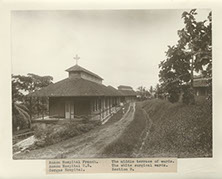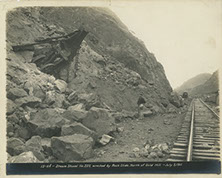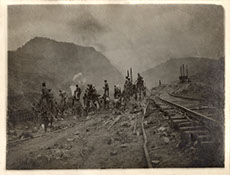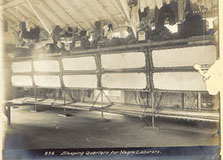The Panama Canal is a remarkable construction feat, whose success depended on technology, determination, and hard labor. The Canal’s success is also intimately tied to health. Health-related issues contributed to the failure of the French effort in the 1880s and enabled the American canal effort in 1904-1914 to succeed. Although plagued by worker injuries, the American endeavor was significantly aided by scientific discoveries that enabled the Americans to proceed with vastly reduced incidence of infectious diseases – especially vector-borne yellow fever and malaria – that so strongly affected canal workers.
William Gorgas, the Sanitary Officer of the Canal. Stereograph. 2013.2.95 Panama Canal Museum Collection, George A. Smathers Libraries. Gift of Bill Angrick.
Malaria Admission Rate Among Employees Panama Canal 1906-1953. 2001.053.030.001 Panama Canal Museum Collection, George A. Smathers Libraries.
Although its cause was unknown, malaria was long recognized as a distinct and specific disease. Some connection to swampy and damp areas was considered.
Ernest "Red" Hallen
Relocation Panama Railroad. Construction Camp showing Old Box Car Bodies used as Living Quarters. 1910. Gelatin silver print. 2003.100.016.001 Panama Canal Museum Collection, George A. Smathers Libraries. Gift of Glen Brandl.


Men burning grass in ditch near railroad tracks. Gelatin silver print. 3.25 in. x 5.5 in. 2000.038.003.064 Panama Canal Museum Collection, George A. Smathers Libraries. Gift of Davis Stevenson.
In 1905 Chief Engineer John Stevens gave Gorgas full reign to implement a robust mosquito control program. Gorgas' methods included fumigation, screening buildings, and burning or smoking grass that could harbor mosquitoes near inhabited areas.
C. Endara
Ancon Hospital French. The middle terrace of wards. Ancon Hospital U.S. The white surgical wards. Gorgas Hospital. Section B. 2013.8.12 Panama Canal Museum Collection, George A. Smathers Libraries.
Ancon Hospital near Panama City had wards for Gold roll employees and silver roll workers, although yellow fever patients were isolated. An insane asylum, leprosarium, sanitarium, and hospital for Panamanians and other non-employees were also included in the healthcare system.
Letter of Employment for Anna L. Doolittle, Nurse. 1907. 2004.094.002.003 Panama Canal Museum Collection, George A. Smathers Libraries. Gift of Martha Gibson.
Ernest "Red" Hallen
Steam Shovel No. 225, wrecked by Rock Slide, North of Gold Hill. 1911. Gelatin silver print. 2000.029.023 Panama Canal Museum Collection, George A. Smathers Libraries. Gift of Doris and Ken Tuley.
In 1908, accidents began to exceed disease as the cause of sick days. Federal workers’ compensation coverage for those employed by the U.S. government in specific types of construction work was passed May 30, 1908. Compensation was calculated on the basis of salary.


Pneumatic Drills, Culebra Cut. 1913. Gelatin silver print. 4 in. x 3in. 2013.1.494 Panama Canal Museum Collection, George A. Smathers Libraries. Gift of Frank Mcleod.
To begin excavation, tripod pneumatic drills were lined up near each other and operated in unison. As of 1913, two men were required to operate each drill. The resulting holes were then loaded with dynamite. Even without the threat of explosion, the noise and vibration of the unison batteries of drills boring through rock and packed earth must have adversely affected unprotected ears and bones.
Ernest "Red" Hallen
Sleeping quarters for Negro Laborers. Gelatin silver print. 2000.029.020 Panama Canal Museum Collection, George A. Smathers Libraries. Gift of Ted and Patsy Norris.
Ernest "Red" Hallen
Sleeping quarters for European Laborers. Gelatin silver print. 2014.43.1 Panama Canal Museum Collection, George A. Smathers Libraries.
Ernest "Red" Hallen
Interior Mess Hall for European laborers - Gold Hill. Gelatin silver print. 2003.017.013.001 Panama Canal Museum Collection, George A. Smathers Libraries. Gift of Patricia Hill.
Working conditions and housing and dining facilities for the silver, unskilled laborers rendered them more vulnerable to illness. They lived without screening, pavement, and covered sewers; crowded living quarters; unappealing food eaten standing up; and long hours at physically demanding tasks in rain or unrelenting sunshine and sometimes in standing water.

This online exhibition is based on the Panama Canal Centennial exhibitions that were organized by the George A. Smathers Libraries to celebrate the centennial of the opening of the Panama Canal. The exhibitions were presented across the University of Florida campus, including the Fisher School of Accounting, Florida Museum of Natural History, Legal Information Center, Samuel P. Harn Museum of Art, and Smathers Libraries. All items are part of the Panama Canal Museum Collection, Special & Area Studies Collections, George A. Smathers Libraries, University of Florida unless otherwise noted.
View the complete object lists from the centennial exhibitions
The Panama Canal is a remarkable construction feat, whose success depended on technology, determination, and hard labor. The Canal’s success is also intimately tied to health. Health-related issues contributed to the failure of the French effort in the 1880s and enabled the American canal effort in 1904-1914 to succeed. Although plagued by worker injuries, the American endeavor was significantly aided by scientific discoveries that enabled the Americans to proceed with vastly reduced incidence of infectious diseases – especially vector-borne yellow fever and malaria – that so strongly affected canal workers.
William Gorgas, the Sanitary Officer of the Canal. Stereograph. 2013.2.95 Panama Canal Museum Collection, George A. Smathers Libraries. Gift of Bill Angrick.
Malaria Admission Rate Among Employees Panama Canal 1906-1953. 2001.053.030.001 Panama Canal Museum Collection, George A. Smathers Libraries.
Although its cause was unknown, malaria was long recognized as a distinct and specific disease. Some connection to swampy and damp areas was considered.
Ernest "Red" Hallen
Relocation Panama Railroad. Construction Camp showing Old Box Car Bodies used as Living Quarters. 1910. Gelatin silver print. 2003.100.016.001 Panama Canal Museum Collection, George A. Smathers Libraries. Gift of Glen Brandl.
Men burning grass in ditch near railroad tracks. Gelatin silver print. 3.25 in. x 5.5 in. 2000.038.003.064 Panama Canal Museum Collection, George A. Smathers Libraries. Gift of Davis Stevenson.
In 1905 Chief Engineer John Stevens gave Gorgas full reign to implement a robust mosquito control program. Gorgas' methods included fumigation, screening buildings, and burning or smoking grass that could harbor mosquitoes near inhabited areas.
C. Endara
Ancon Hospital French. The middle terrace of wards. Ancon Hospital U.S. The white surgical wards. Gorgas Hospital. Section B. 2013.8.12 Panama Canal Museum Collection, George A. Smathers Libraries.
Ancon Hospital near Panama City had wards for Gold roll employees and silver roll workers, although yellow fever patients were isolated. An insane asylum, leprosarium, sanitarium, and hospital for Panamanians and other non-employees were also included in the healthcare system.
Letter of Employment for Anna L. Doolittle, Nurse. 1907. 2004.094.002.003 Panama Canal Museum Collection, George A. Smathers Libraries. Gift of Martha Gibson.
Ernest "Red" Hallen
Steam Shovel No. 225, wrecked by Rock Slide, North of Gold Hill. 1911. Gelatin silver print. 2000.029.023 Panama Canal Museum Collection, George A. Smathers Libraries. Gift of Doris and Ken Tuley.
In 1908, accidents began to exceed disease as the cause of sick days. Federal workers’ compensation coverage for those employed by the U.S. government in specific types of construction work was passed May 30, 1908. Compensation was calculated on the basis of salary.
Pneumatic Drills, Culebra Cut. 1913. Gelatin silver print. 4 in. x 3in. 2013.1.494 Panama Canal Museum Collection, George A. Smathers Libraries. Gift of Frank Mcleod.
To begin excavation, tripod pneumatic drills were lined up near each other and operated in unison. As of 1913, two men were required to operate each drill. The resulting holes were then loaded with dynamite. Even without the threat of explosion, the noise and vibration of the unison batteries of drills boring through rock and packed earth must have adversely affected unprotected ears and bones.
Ernest "Red" Hallen
Sleeping quarters for Negro Laborers. Gelatin silver print. 2000.029.020 Panama Canal Museum Collection, George A. Smathers Libraries. Gift of Ted and Patsy Norris.
Ernest "Red" Hallen
Sleeping quarters for European Laborers. Gelatin silver print. 2014.43.1 Panama Canal Museum Collection, George A. Smathers Libraries.
Ernest "Red" Hallen
Interior Mess Hall for European laborers - Gold Hill. Gelatin silver print. 2003.017.013.001 Panama Canal Museum Collection, George A. Smathers Libraries. Gift of Patricia Hill.
Working conditions and housing and dining facilities for the silver, unskilled laborers rendered them more vulnerable to illness. They lived without screening, pavement, and covered sewers; crowded living quarters; unappealing food eaten standing up; and long hours at physically demanding tasks in rain or unrelenting sunshine and sometimes in standing water.
This online exhibition is based on the Panama Canal Centennial exhibitions that were organized by the George A. Smathers Libraries to celebrate the centennial of the opening of the Panama Canal. The exhibitions were presented across the University of Florida campus, including the Fisher School of Accounting, Florida Museum of Natural History, Legal Information Center, Samuel P. Harn Museum of Art, and Smathers Libraries. All items are part of the Panama Canal Museum Collection, Special & Area Studies Collections, George A. Smathers Libraries, University of Florida unless otherwise noted.
View the complete object lists from the centennial exhibitions